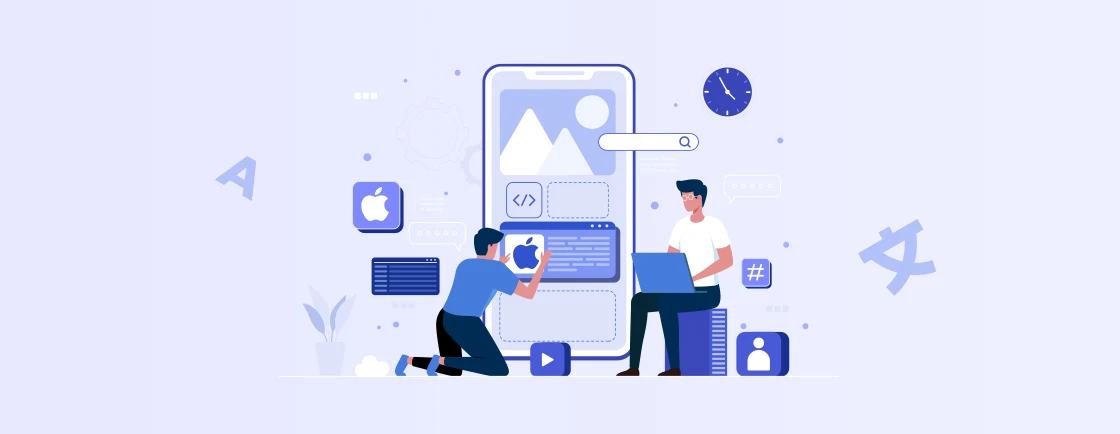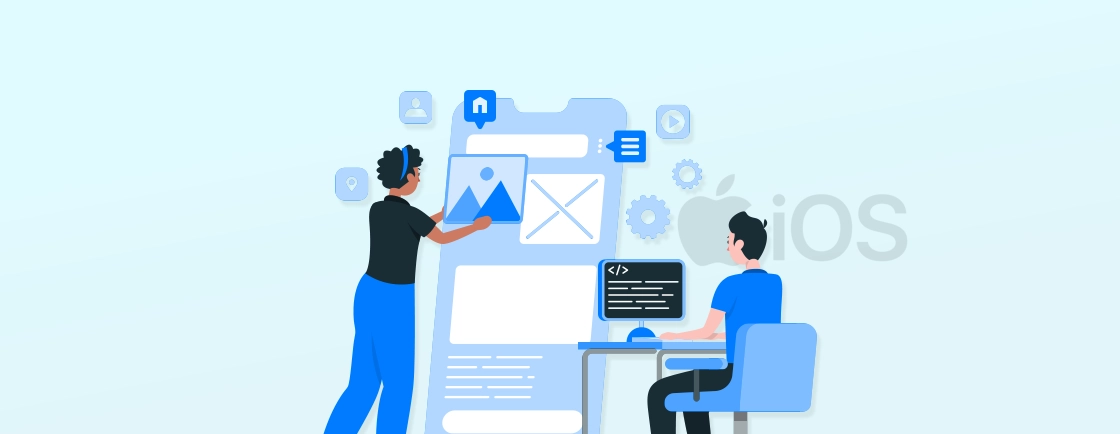Table of Contents
Thinking about building an iOS app but unsure about the costs? You’re not alone. Budgeting for an app involves multiple factors—features, design, development time, and maintenance. Each of these impacts the final price.
A simple app may start around $10K, but more complex iOS apps may exceed even $100K. And needless to say, some apps with advanced functionalities or in-demand niches, like gaming or social media may even go in multiples of hundreds of thousands.
Understanding these variables helps businesses allocate resources wisely and avoid unexpected expenses. So through this blog, I’ll explain the factors considered by the iOS app experts to determine the cost of the application. Without further ado, let’s begin.
How Much Does It Cost to Develop an iOS App?
The cost of developing an iOS app varies widely—anywhere from $5K for basic apps to $500K for feature-rich, enterprise-level apps like Instagram, YouTube, etc. Factors like app complexity, design, development team rates, third-party integrations, and more–all influence the final price.
Simple apps – $10,000 to $50,000
Basic apps with standard features like login screens, simple dashboards, and limited functionality. Examples include calculators, basic fitness trackers, or informational apps.
Includes:
- Basic UI/UX design (pre-made templates, limited customization)
- Core features (user login, simple dashboard, static content)
- No backend or a lightweight one (Firebase or basic APIs)
- Limited third-party integrations (e.g., social media login)
- Single-platform development (iOS only)
This kind of app may take around 2 to 4 months to develop and launch.
Mid-range Apps – $50,000 to $150,000
These are more polished apps with custom UI, API integrations, and moderate complexity. Examples include eCommerce apps, booking systems, or social media platforms.
Includes:
- Custom UI/UX design (tailored to brand identity)
- Advanced features (in-app purchases, payments, real-time chat)
- Backend development (Node.js, Ruby on Rails, or Django)
- Third-party integrations (payment gateways, analytics, cloud storage)
- Basic security & scalability (user data encryption, moderate server load handling)
This sort of mobile app may take around 4 to 8 months to develop and launch.
Complex Apps – Exceed $150,000
These are advanced apps with real-time features, AI/ML, or multi-platform sync. Examples include on-demand services (Uber), fintech apps, or enterprise solutions.
Includes:
- High-end UI/UX design (animations, interactive elements)
- Advanced backend (microservices, real-time sync, AI/ML integration)
- Multi-platform support (iOS + Android + Web)
- Complex third-party APIs (Google Maps, AR/VR, IoT)
- Enterprise security & compliance (HIPAA, GDPR, biometric auth)
- Scalable cloud infrastructure (AWS, Azure, Kubernetes)
This kinda complex app will take more than 8 months or even exceed a year in development time.
You may also factor in the likes of App Store fees, backend infrastructure, and post-launch updates.
Top Factors Influencing the iOS App Development Costs
The cost of developing a mobile application is quite subjective, as in, it depends on a range of key variables. Understanding these factors will help you budget effectively and avoid surprises. Let’s look at the cost drivers.
App Complexity & Features
The more features (user auth, real-time chat, AI, etc.), the higher the cost. A basic app with minimal functionality costs less. But advanced apps entail custom animations, offline mode, complex algorithms, and more. That requires more development time and expertise, increasing the budget.
- Basic apps (to-do lists, calculators): $10K–$50K
- Moderate apps (e-commerce, social features): $50K–$150K
- Complex apps (AI, real-time sync, enterprise): $150K+
All in all, the more the features, the higher the development time and cost.
UI/UX Design
Custom, polished designs cost more than template-based ones. High-end animations, micro-interactions, and accessibility features add to expenses. Investing in good UX reduces long-term costs by minimizing user drop-offs and redesign needs.
- Template-based design: $2K–$10K
- Custom UI/UX with animations: $15K–$50K+
While premium design enhances the looks and usability, it also increases costs.
Development Team Location & Rates
Developer rates vary by region—North America vs. Eastern Europe vs. South Asia. Freelancers may be cheaper than agencies but risk inconsistent quality. Offshore teams can cut costs but require strong project management.
- Freelancers: $20–$50/hour
- Agencies (US/EU): $80–$150/hour
- Offshore teams (Asia/Eastern Europe): $30–$80/hour
So as you would expect location drastically impacts labor costs.
Backend & Infrastructure
Apps needing databases, user management, or cloud storage (AWS, Firebase) cost more. Scalable backends for high-traffic apps add complexity. But serverless setups can reduce initial expenses but may limit future growth.
- Basic (Firebase, simple APIs): $5K–$20K
- Advanced (AWS, microservices): $30K–$100K+
Two of the key factors that add to the expenses are scalability and security.
Third-party Integrations
APIs (payment gateways, social logins, analytics) save time but may incur licensing fees. Custom integrations (CRM, IoT, or legacy systems) require additional development, increasing costs.
- Standard (payment gateways, social login): $3K–$10K
- Advanced (AI APIs, IoT, blockchain): $15K–$50K+
All in all, the more the integrations, the higher the development efforts and costs.
App Store Deployment
Apple’s $99/year developer fee is just the start. App Store compliance, beta testing, and ASO (App Store Optimization) add hidden costs. Rejected submissions mean extra fixes and delays.
- Basic Apple Developer Fee: $99/year (fixed)
- App Store Optimization (ASO) & Compliance: $1K–$10K
Other than these, people often overlook legal and marketing costs for the app.
Maintenance & Updates
Post-launch costs (bug fixes, iOS updates, new features) typically run 15-20% of initial development annually. Neglecting maintenance leads to crashes, poor reviews, and lost users.
- Annual maintenance (bug fixes, minor updates): 15–20% of initial cost
- Major upgrades (iOS compatibility, new features): $10K–$50K/year
Post-launch costs are associated with any app. They are critical in ensuring long-term success.
Even considering these factors, it’s a little tricky to break down the cost of your iOS app. For that, you can consult with our iOS app development company. We can provide you with a precise estimate in no time.
Android vs iOS App Development Costs
When exploring the cost of mobile app development, a common question is whether to build for Android, iOS, or both. While the overall investment in development on both platforms will be quite similar, there are some nuances to consider.
iOS apps are generally more expensive to develop. When it comes to global averages, while Android apps come out at around $23K, iOS apps come out at roughly $28K. But on the flip side, iOS app development is less complex due to limited device variety. With Android, there are innumerable devices with more coming out every day. So there are compatibility issues.
And if you have opted for cross-platform app development, the costs will be higher. You’ll have to keep two different operating systems in mind during the design and development phase.
While a limited number of devices mean lower test costs, higher quality entails rigorous testing. That along with the quality assurance and maintenance would mean higher costs.
Let’s Conclude
Developing an iOS app is a strategic investment—one that balances cost, quality, and long-term value. The cost of development can be anywhere from $5K to $150K based on whether it’s a basic app or a complex app. And the niche will also dictate the price.
Prices vary widely based on features, design, and team structure. But understanding these factors helps you allocate your budget effectively. A well-planned app not only fits your financial constraints but also delivers a seamless user experience. That ensures higher adoption and retention.
Need a tailored estimate for your project? Hire iOS app developers from our team today and get expert guidance every step of the way.
FAQs on iOS App Development Costs
What’s the biggest cost factor in iOS app development?
App complexity—more features (like AI, payments, or real-time sync) increase development time and cost. Custom UI/UX and backend infrastructure also significantly impact pricing.
Does hiring freelancers reduce costs?
Yes, freelancers ($20–$50/hour) are cheaper than agencies ($80–$150/hour), but managing quality and timelines can be challenging. Offshore teams ($30–$80/hour) offer a balance between cost and reliability.
How much does app maintenance cost?
Expect $5,000 to $30,000 per year for updates, bug fixes, and iOS compatibility. Major upgrades (new features) cost more.
Should I develop for iOS or Android first?
If your audience is high-income or US-based, iOS first is ideal. For global reach, Android may be better. Budget permitting, cross-platform development solves this dilemma.
Can I change iOS app features mid-development?
Yes, but scope changes increase costs by 15–50% due to rework. A detailed plan upfront prevents budget overruns.
Are no-code app builders a cheaper alternative?
Yes ($1K–$10K), but they’re limited to very basic apps with no scalability. Custom apps offer better performance and long-term ROI.
Craft Exceptional iOS Applications
Delve into best practices, Swift tutorials, and design principles to create outstanding iOS apps.





